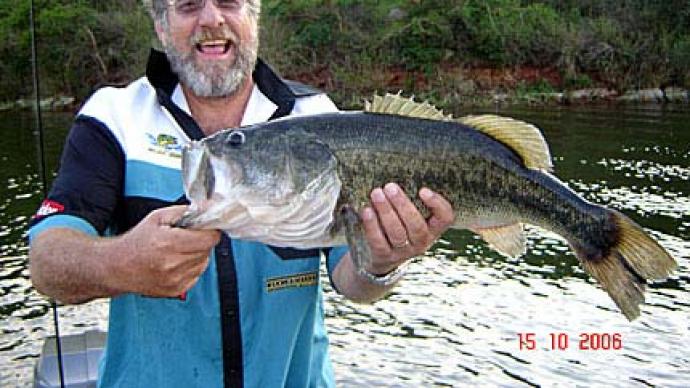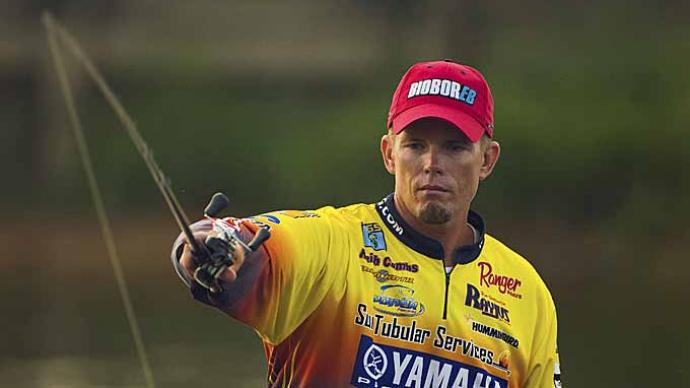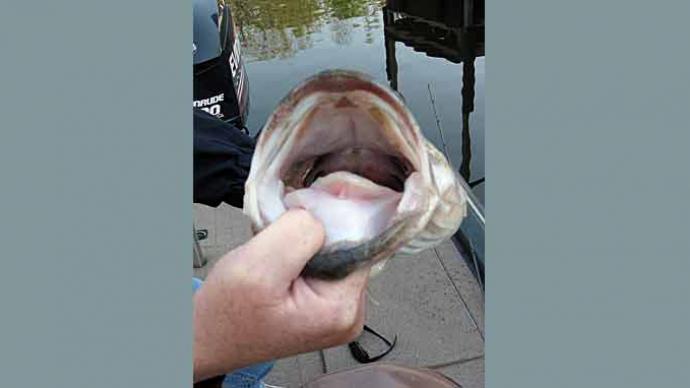
It is because I spend the weekdays at work and relish my time on the lake during the weekends that has forced me, like many of you, to fish when I can. And often, despite the weather. If given a choice, I will always take rain over the wind. You can stay dry if you use proper judgment in getting good rain gear, but you can do little about the part of the lake taken from you when the winds get high. When planning for a tournament, it is always good to consider potential wind directions and scout out areas as fallback positions if you are forced to leave the primary areas because of waves. Of course, this implies you can find more than one productive fishing spot.
A few years ago, a fishing buddy and I were going to fish a tournament on Sam Rayburn (Texas). The tournament was in November, and as often happens in the mid-fall season, there was a string of beautiful warm days. During this time, I found a concentration of bass in the Black Forest area. We were overconfident that we could get a quick limit and start culling for the remaining parts of the day. A front came through on the night before the tournament's first day, and 30-plus miles per hour west winds greeted us at start time. We finally decided to go to the spot even though the swells looked more like the gulf than a freshwater lake. We could not feel a strike, much less stay in the proper position to work the area. We should not have been as dependent as we were on that one spot.
The following year we fished a team tournament on the same lake, and for the first time, the director felt the wind was so strong that safety dictated contestants could trailer from Twin Dikes if they desired. Burned the year before, we now had not one but several fallback locations. Most of these were in areas where we would be protected from west or north winds. It would have been highly likely that several local teams would have been very tough to beat. They were rattled since their fish were in the same open-water areas that we had counted on in the previous year.
We had some criteria for determining how we worked out the fallback areas. For starters, the areas had to be protected from a frontal wind pattern, the cove had to have some deep water within the area, and finally, there had to be good structure and cover. Ironically, the chance to trailer was an actual good-luck event since one of the coves also had a small Corps of Engineers' ramp in the back. We never overlook an area just because it has a ramp nearby. There is a good chance that many of these areas are sites for folks to launch. But we all know you must run a considerable distance from a ramp to catch fish = WRONG.
One of the biggest concerns when running on windy days is safety. The waves suddenly hide things you usually see, and in some cases, this can include brush or logs that get moved around by the wind. When the water temperature is cold, the other problem is that it is hard to avoid getting sprayed, particularly when running sideways to the waves. Yet many folks do not put on rain gear when crossing windy areas and think about it a little late, like after they're wet. Some boats are dryer than others, but all will get one or the other side of the boat wet with side spray from high waves.
Windy conditions in warm weather have less risk of causing hypothermia, but all other risks remain. Modern bass boats can take a beating from waves and return for more. However, as a warning for the driver and passenger, you may think the macho image of a boat busting the waves is neat. Still, over time a proven difference will be felt between the durability of the fiberglass and your spinal column.
Summertime winds from thunderstorms are hazardous. These are not typically sustained winds but often come up suddenly without any way to guess how long they will be blowing. The other concern about thunderstorm-induced winds is that they can shift as the storm shifts. If you have a long run in such conditions, the prevailing winds can, through the shift, change you from a more protected path to an exposed one in a matter of minutes. Therefore, the best thing to do in thunderstorm conditions is to get to safety within a sufficiently large margin of time to be safe.
There are those takes on which a fisherman simply has to adjust his technique to fish and expect to run in windy conditions since the wind generally blows. If that is the case, or if you simply want the option to fish in swells if you desire, then make sure your trolling motor shaft is sufficiently long to permit you to keep it in the water as you go up and down in the swells. The higher your boat floats, the longer a shaft you need to enable you to lower it when you are fishing swells.
There are some trade-outs in getting extra long shafts for your trolling motor. With the metal shafts, the longer the distance from the lower bearing assembly on the main tube to the motor, the more physical leverage you place on the shaft. Now if you only fish in open water, then you are okay. However, if you fish in stumps, the flex caused by the motor hitting an obstacle is much like a simple physics problem in that the further away the pressure is exerted on the end, the greater the likelihood of the shaft bending.
On the other hand, a buddy who fishes Amistad and Falcon (which have their share of windy days) decided to get a special modification of his trolling motor to face these conditions. He had a unique 60-inch shaft machined for his motor since he wanted to hold the boat's position without the motor coming out of the water in swells, which results in cavitations of the prop. I particularly like the motor because when he collapses it in the resting position, it comes so far back that it makes an excellent armrest for the passenger.
If you are bound and determined to fish in swells, you better have a strong trolling motor and good batteries and carefully choose your baits. You might choose to use extra heavy-weight lead if you hope to feel soft plastic baits. A Carolina rig is an excellent choice to give you the best chance of sensing a strike.
The other groups of baits that work in rough water are the cranks. You do not have to feel the strike with these baits. Just keep a tight line on retrieve; the trebles will compensate for your lack of feeling. If you can get by with it, shift to lighter line when fishing in heavy wind conditions. The smaller diameter line gives a better feel under any condition. However, it can really help you when you have to overcome both the effects of waves and the pressure of the wind on the line.
If a lot of wind is a pain in the neck, a little wind is often a great help. For starters, wind action can shift forage toward the shore where the waves are breaking. When the bait is concentrated, predators won't be far behind. Bass will often push bait into the shallow areas where wave action occurs. An advantage that bass have in feeding in areas with wave action is the same that we, as anglers, have trying to catch the bass. The chop from the wave action creates visibility changes in the water. The bass in such areas are less likely to be spooked by the presentation of a lure. They are also much less exposed to the impact of sunlight than bass in calmer shallower water, where the sun's direct rays are altered little by the smooth surface.
The choice for working shallower waters, particularly where waves are breaking, should start with a spinnerbait. These are "finder baits" at any time, but the vibration amid breaking waves can trigger action. Baitfish draw the bass whether they are being blown into the shallows or are simply going to where there is bottom turbulence, which produces food for the smaller guys. A white spinnerbait is a good starting color since it portrays the color of shad or minnows. A fallback choice is chartreuse since Bream also check out the food menu that the roughed-up bottom has released.
If you think bass are in the wave-created turbulence because of food, don't overlook that crayfish are also disturbed and moving in such areas. In the case of the latter food source, nothing works better in imitating their action than a pegged craw worm, lizard, or worm. The more the wave action, the shallower bass may be found. It's not unusual to see bass chase schools of shad into such an area, and some of the shad panic to the level that they jump on the bank.
The rule of thumb, which can apply to fishing windy shorelines, is that you can often catch fish very shallow. However, the deeper you fish in such areas, the greater your chance of catching some larger fish. This works similarly to fishing a summertime school of bass. The real movers and shakers are usually the smaller fish, with the larger fish in the area holding back to pick up the strays or grab wounded prey that have gotten out of the primary battleground.
I started this article by emphasizing the importance of respecting the wind and its impact on safety. When you cut to the quick, this is much more important than how to catch fish because we are talking about your life. We are all familiar with the sad stories of folks who misjudged the strength of the wind, resulting in tragedy. However, for every one of those stories, there are hundreds where the story ended on a positive note but could have been different. Ninety percent of the folks I have seen fall out of boats have been related in one way or the other to the wind.
A mixture of wind and stumps is hazardous since you have to be prepared to balance yourself from both the shifting due to the waves and the unexpected fusing of your boat with a stump. Indeed, the wave action hides subsurface stumps, which you would easily see while running the trolling motor. Taking a dip in the summer can be funny, but falling in with a complete covering of winter clothes and nice warm boots is equivalent to jumping in with an anchor tied around your neck.
To avoid being surprised by a potential storm or wind shift, ensure you have a weather radio with you. It may come as a surprise, but many weathermen on the tube have not had a course in meteorology and rely on "canned" data fed to them in the form of a forecast. The folks at NOAA (the weather radio people) are not only getting data from the national weather service in a given area but are updating it every few hours or sooner in the case of severe weather. By using some discretion, you can stay safe in some cases.
Take advantage of the wind, or at the least, don't miss a fishing trip because of it. If you do a little pre-trip planning, you can usually overcome the challenges of the wind. Otherwise, it will be a long season for those who fish on weekends.




